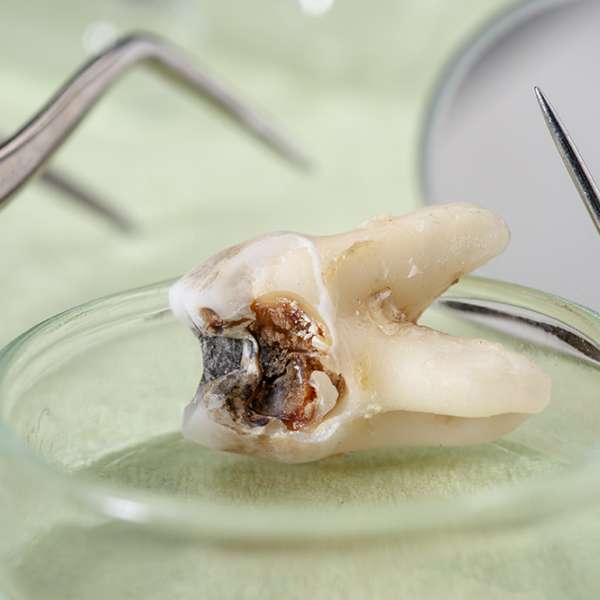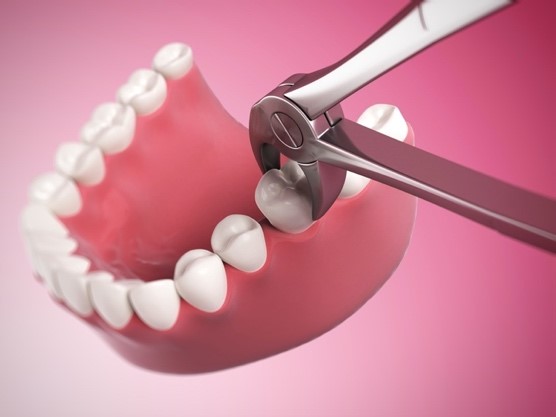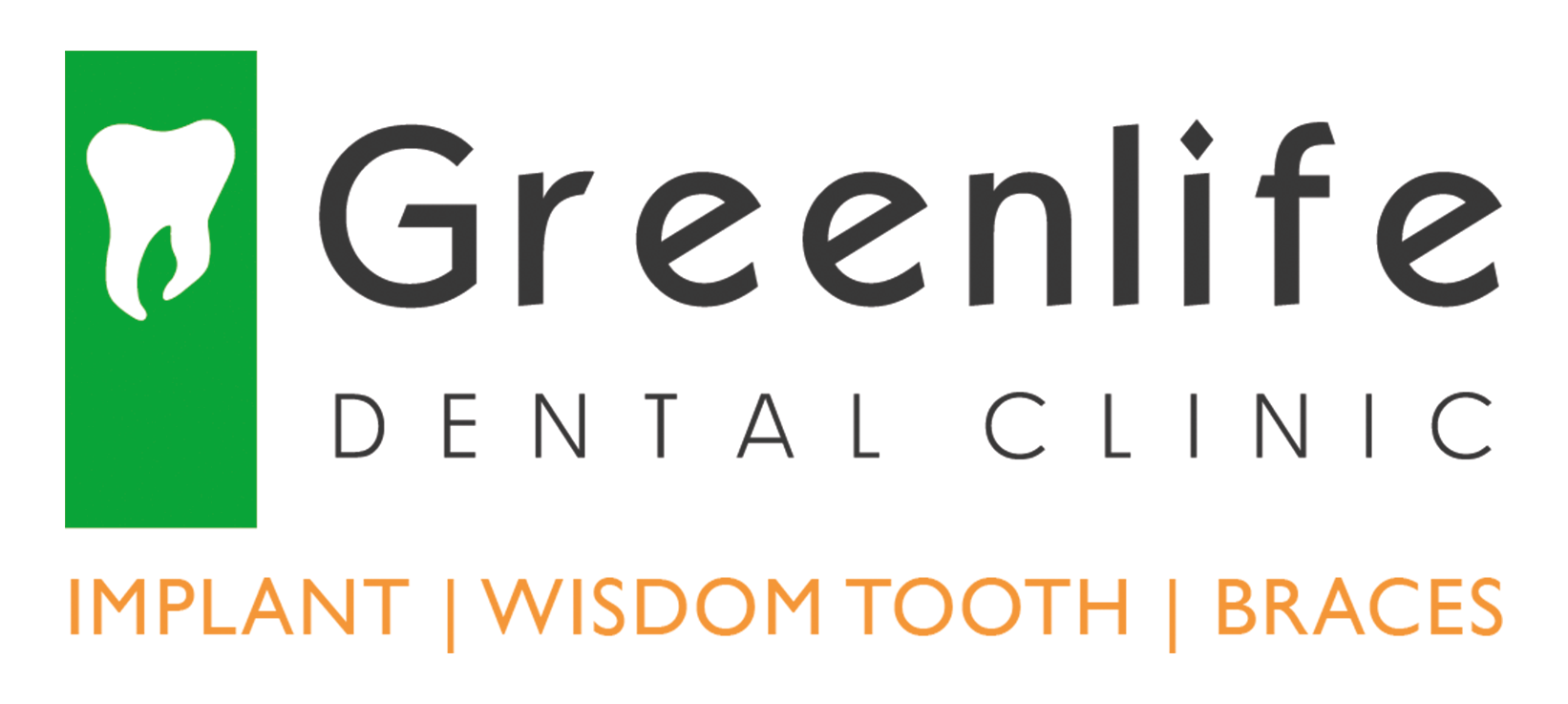What is a Tooth Extraction?
Tooth extraction is the removal of a tooth from its socket in the jaw bone. It is done under local anaesthesia and should be a painless procedure. The tooth is removed with the help of dental instrument and the tooth usually can be removed as a single piece.
Sometimes, when the tooth is badly broken down, it becomes fragile. Such tooth may need to be removed by cutting it into smaller pieces and even removing some of the bone that is holding it, to make the extraction easier.
Why Should You Do Tooth Extraction?


Extraction should be the last resort when a problematic tooth cannot be save by the available dental treatment or it is better to remove it in order to save and protect adjacent teeth, eg. crooked wisdom tooth or crowded teeth that make cleaning difficult.
However, some patient may choose extraction as a cheaper alternative as it usually cost less than other treatment like root canal treatment or crown.
Removing a tooth should really only be a last resort and not done out of convenience, cost or fear of the recommended dental treatment.
Decision to remove it should be made with the long-term side effects of losing that tooth kept in mind.
An empty space left by the extracted tooth ideally should be replaced with either a denture, bridge or dental implant.
The missing tooth will affect your appearance and how your confidence level if it is visible when your talk or smile. It will also affect how you eat and speak.
If left not replaced for a long time, adjacent and opposing teeth will shift and move into the empty space, creating unsightly gaps that will trap food, causing tooth decay and gum disease.
This will in turn, cause more teeth to be removed, thus creating a vicious cycle of losing more and more teeth in the future.
As a general advice, it is best to keep your own teeth for as long as possible. If it has to be extracted, it is better to have it replaced with either a denture, bridge or dental implant then to leave the gap empty.
How Long Does the Procedure Take?


For a surgical extraction, it can take about 30 to 60 minutes depending on the tooth involved and complexity of the removal.
Types of Extractions
Simple extraction – This is done with the help of an extraction forceps that will loosen the tooth from the jaw by slowly expanding the bony support that hold the tooth. The tooth usually will be removed as a single complete piece.
Sometimes, a badly broken-down tooth may fracture during the extraction process or make it hard to be gripped by the forceps, then our dentist may proceed to do a surgical extraction.
Surgical extraction – This is a more complex procedure to remove the tooth that cannot be gripped by the extraction forceps or that had fractured during the extraction process.
The dentist will need to cut the tooth into smaller pieces or bone to make the extraction easier. Many wisdom teeth are grown crooked or impacted (jammed) against the adjacent tooth, thus require surgical extraction to remove them.
For this procedure, you can use your Medisave to pay for the treatment. Check with our dentist to see if your case is suitable for Medisave claim.
Is Tooth Extraction Painful? What Can I Expect During an Extraction?
Tooth extraction should be a painless procedure as local anaesthetic will be applied to the area. Our dentist will apply some cream to numb the gum to remove any discomfort during the injection.
During the extraction, you should not feel any pain but you can still feel the pressure while the dentist applies force to loosen the tooth gently will different instruments. This may involve some rocking or wriggling motions but you can only feel the force of the pressure, but it should not be painful.
In the unlikely event that you start to feel any pain, do alert our dentist so that we can apply more anaesthetics to that area before continuing with the procedure.
FAQs
What do I do after a tooth extraction?
After the extraction of a tooth, our dentist will place a piece of cotton gauze into the bleeding socket. It is most important for you to apply pressure on the wound by firmly, biting down on the gauze to help stop the bleeding. Occasionally, our dentist may place a few stitches to close the gum over the socket if necessary.
Please bite firmly on each piece of gauze for at least 1 to 2 hours. The main purpose of the gauze is to apply pressure on the fresh wound of the socket to stop the bleeding and not meant to absorb the blood. Do not wash or rinse your mouth frequently as this action will dislodge the clot formed and create fresh bleeding. Expect some oozing of blood from the socket for the next 24 hours. More gauze will be given for you to change along the way. Do call our dentist if you are concern if you think that the bleeding is not stopping after a few hours.
I have a missing tooth after extraction. What should I do?
Find out more how can you replacing your missing tooth after the extraction or if you had lost your tooth long ago.
Can I eat right after extraction?
You can eat after extraction when the anaesthesia had worn off so that you can feel and taste your food. There is no need for any diet restriction as long as you feel comfortable.
What to expect after the extraction?
You will be given pain killers to relieve the pain of the extraction when the anaesthesia begins to wear off. Sometime you may be given anti-swelling medication, antiseptic mouthwash or antibiotics if the extraction requires it. You will feel some mild soreness over the extraction site and your face may swell a little. This discomfort should subside in 2-3 days after the extraction. If you continue to experience pain or swelling for more than 3 days or when the pain worsened, do contact our dentist immediately as this may be a sign of infection at the extraction site.
You will be given 1-2 days of medical leave if you need to rest from work. Many times, our patients will resume their daily routine the next day especially when a simple extraction is done. More days of rest may be required for surgical removal of tooth.
Can I use Medisave for my extraction?
For simple extraction, you cannot use Medisave for this procedure.
You can use your Medisave for only surgical extraction, that is those that involve drilling of the tooth and bone and wisdom tooth surgery. You can claim the surgical procedure from your Medisave account and there is no need to top up with cash from your pocket.
Can I do a filling instead of extracting my tooth?
Yes, you may but this is not the recommended treatment of choice as the tooth is already infected and the nerve (pulp) is dead. Filling is just to cover the hole of the broken or decayed portion of tooth structure but it does not treat the infection of the tooth which is only can be solved by root canal treatment or extraction. Sometime placing a filling on an already infected tooth may cause even more pain as the infection is now sealed inside the tooth chamber and will spread downward through the roots to the surrounding bone and gum.
How long does it take to heal from an extraction?
Recovery will take placed immediately as the clot forms inside the socket of the extraction tooth. It is normal to feel some pain or discomfort when the anaesthesia has worn off. Do take the pain-killer or any other medication prescribed to you immediately when you reach home. This is to allow time for the medication to be absorbed into your body before the anaesthesia wears off. You can eat on the other side of the extraction anything that you feel comfortable except hot and spicy food that may irritate the wound. There is no need to go into a soft diet.
The new gum tissue will form inside the socket of the extracted tooth in about 1-2 weeks and slowly fill up the empty socket. The hole will get shallower with time. You can start chewing normally at the extraction area in 1-2 weeks. Over the period of next 3-6 months, the soft tissue inside the socket will slowly hardened to form new bone.
Can I not replace the missing tooth after the extraction?
It depends on which tooth was extract and if replacement is necessary for function in chewing or esthetics. If the wisdom tooth (third molars) was extracted, there is no need to replace this tooth as it does not affect your chewing function or the integrity of the dental arch. However, if the tooth removed is not the wisdom tooth, it may start to cause problem such as shifting of neighbouring teeth that cause food trap that may lead to gum disease and tooth decay. Discuss with our dentist how you may want to replace the missing tooth in order to prevent future problems and to restore back your ability to chew and smile properly again.

